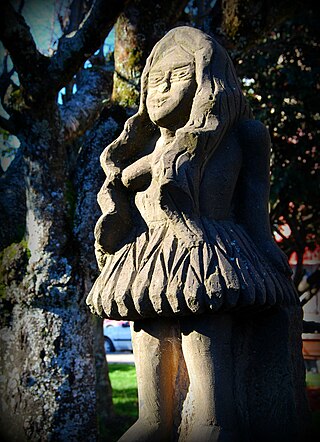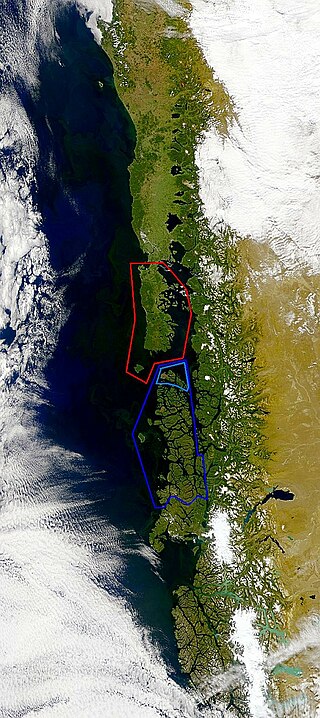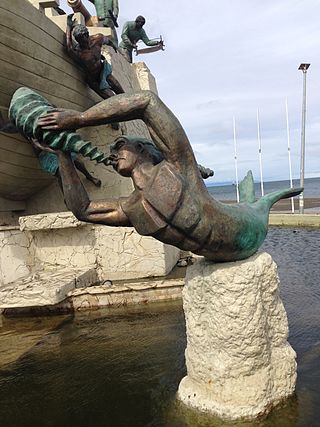
Chiloé Island also known as Greater Island of Chiloé, is the largest island of the Chiloé Archipelago off the west coast of Chile, in the Pacific Ocean. The island is located in southern Chile, in the Los Lagos Region.

In the traditional Chilote mythology of Chiloé, Chile, the Trauco is a humanoid creature of small stature—similar to a dwarf or goblin—who lives deep in the forest. It has an ugly face and legs without feet.

The Pincoya is, according to local mythology, a female "water spirit" of the Chilotan Seas. The Pincoya is said to have long blond hair, be of incomparable beauty, be cheerful and sensual, and rise from the depths of the sea.

Chilote is a dialect of Spanish language spoken on the southern Chilean islands of Chiloé Archipelago. It has distinct differences from standard Chilean Spanish in accent, pronunciation, grammar and vocabulary, especially by influences from local dialect of Mapuche language and some conservative traits.

In the Chilote folklore and Chilote mythology of Chiloé Island in southern Chile, the imbunche is a legendary monster that protects the entrance to a warlock's cave.
The Chilote mythology or Chilota mythology is formed by the myths, legends and beliefs of the people who live in the Chiloé Archipelago, in the south of Chile. This mythology reflects the importance of the sea in the life of Chilotes.
The legend of Trentren Vilu and Caicai Vilu (Kaikai) is a Mapuche flood myth that tells the story of a fierce battle between two mythical snakes, Trentren Vilu and Caicai Vilu. It explains how the Chilóe archipelago and mountains of southern Chile came to have its unique geography.
The warlocks of Chiloé are people of Chiloé Archipelago said to practise witchcraft linked to Chilote mythology. The warlocks may be real, purported or legendary persons. The source of the witchcraft is often attributed to a legendary encounter between Basque navigator José de Moraleda y Montero and Huilliche machi Chillpila who defeated Moraleda in a duel of witchcraft obtaining a book of European magic as reward. Belief in witchcraft has been common in the archipelago, reaching such influence that in 1880 Chilean authorities put on trial warlocks said to rule the archipelago through a secret society.
The Piuchén is a creature from the Mapuche mythology and Chilote mythology pertaining to southern Chile, a much feared shapeshifting creature that can instantly change into animal form. According to legend, the Piuchén takes the hearts of its victims without leaving a mark on the body.
The Basilisco chilote is a creature from Chilota mythology originating from the Chiloé Archipelago, in southern Chile.
Chilean mythology includes the mythology, beliefs and folklore of the Chilean people.

The Chiloé Archipelago is a group of islands lying off the coast of Chile, in the Los Lagos Region. It is separated from mainland Chile by the Chacao Channel in the north, the Sea of Chiloé in the east and the Gulf of Corcovado in the southeast. All islands except the Desertores Islands form Chiloé Province. The main island is Chiloé Island. Of roughly rectangular shape, the southwestern half of this island is a wilderness of contiguous forests, wetlands and, in some places, mountains. The landscape of the northeastern sectors of Chiloé Island and the islands to the east is dominated by rolling hills, with a mosaic of pastures, forests and cultivated fields.

Guaitecas Archipelago is a sparsely populated archipelago in the Aisén region of Chile. The archipelago is made up of eight main islands and numerous smaller ones. The eight largest islands are from northwest to southeast: Gran Guaiteca, Ascención, Betecoy, Clotilde, Leucayec, Elvira, Sánchez and Mulchey. The islands have subdued topography compared to the Andes, with Gran Guaiteca containing the archipelago's high point at 369 m (1,211 ft).
The Pincoy is a male water spirit of the seas, belonging to the Chilote mythology of Chiloé, Chile.
La Sirena chilota is an aquatic creature belonging to the Chilote mythology. Perhaps its origin is due to binding of the myths of the Sumpall of the Mapuche mythology and the Mermaid of European mythology. Like to the mermaids, the siren chilota is characterized by a body half fish and half woman, with blond hair and golden scales; and her human side would look like a very beautiful teen. She would be the youngest daughter of Millalobo and the human Huenchula. Commissioned by her father, she has the task of caring for all fish. Also helps her siblings to carry the bodies of drowned sailors, toward the Caleuche, for the purpose of reviving the sailors and to be happy. Sirena Chilota have very large flukes and strong tails so they can swim long distances while carrying victims of tragedies. It is also said that a Sirena chilota's tears are very delicate and, if used in a spell, is very powerful.

The Chiloé Archipelago is home to a wide variety of potatoes. After the Titicaca region of Peru and Bolivia, it is the geographical nucleus where the most different types of potatoes are found. Evidence ranging from historical records, local agriculturalists, and DNA analyses strongly supports the hypothesis that the most widely cultivated variety of potato worldwide, Solanum tuberosum tuberosum, is indigenous to the Chiloé Archipelago, and has been cultivated by the local indigenous people since before the Spanish conquest. Unlike potatoes from Peru and Bolivia, the potatoes of Chiloé are adapted to the long summer days of the higher latitude region of southern Chile. After the disastrous European Potato Failure in the 1840s, strains originating in the Chiloé Archipelago replaced earlier potatoes of Peruvian origin in Europe.
The Caballo Marino Chilote is an aquatic creature of the Chilote mythology of Chile, that bears some resemblance to the hippocampus.
The history of Chiloé, an archipelago in Chile's south, has been marked by its geographic and political isolation. The archipelago has been described by Renato Cárdenas, historian at the Chilean National Library, as “a distinct enclave, linked more to the sea than the continent, a fragile society with a strong sense of solidarity and a deep territorial attachment.”

Millalobo is an important being in Chilote mythology. He is the most powerful being of the sea after Caicai and was chosen by Caicai to be his representative and govern all that resided in the sea.
The Caleuche Awards is an awards ceremony presented to recognize the best in performances of the season, in feature films, television serials, miniseries and anthology series, and comedy. They were created and organized by the Corporation of Actors of Chile (Chileactores), sponsored by VTR for their first edition.








